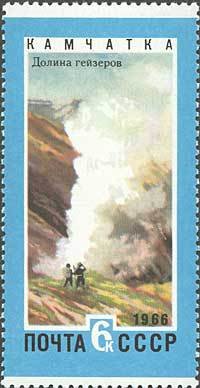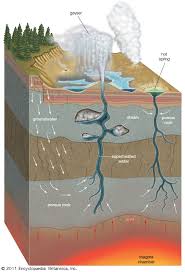Stamp: Geyser's valley (Soviet Union, USSR 1966)
Geyser's valley (Soviet Union, USSR 1966)
25 December (Soviet Union, USSR ) within release Soviet Far Eastern Territories goes into circulation Stamp Geyser's valley face value 6 Russian kopek
| Stamp Geyser's valley in catalogues | |
|---|---|
| Michel: | Mi:SU 3307 |
Stamp is vertical format.
Also in the issue Soviet Far Eastern Territories:
- Stamp - Ship "Saint Pyotr" and map of Komondor islands face value 1;
- Stamp - Medny island and map of Bering and Medny island face value 2;
- Stamp - Petropavlovsk harbour (Kamchatka) face value 4;
- Stamp - Geyser's valley face value 6;
- Stamp - Avatchinskaya bay face value 10;
- Stamp - Northern Fur Seal (Callorhinus ursinus), Bering Islands face value 12;
Stamp Geyser's valley it reflects the thematic directions:
A landscape is the visible features of an area of land, its landforms and how they integrate with natural or man-made features. A landscape includes the physical elements of geophysically defined landforms such as (ice-capped) mountains, hills, water bodies such as rivers, lakes, ponds and the sea, living elements of land cover including indigenous vegetation, human elements including different forms of land use, buildings and structures, and transitory elements such as lighting and weather conditions. Combining both their physical origins and the cultural overlay of human presence, often created over millennia, landscapes reflect a living synthesis of people and place that is vital to local and national identity. The character of a landscape helps define the self-image of the people who inhabit it and a sense of place that differentiates one region from other regions. It is the dynamic backdrop to people’s lives. Landscape can be as varied as farmland, a landscape park, or wilderness. The earth has a vast range of landscapes, including the icy landscapes of polar regions, mountainous landscapes, vast arid desert landscapes, islands and coastal landscapes, densely forested or wooded landscapes including past boreal forests and tropical rainforests, and agricultural landscapes of temperate and tropical regions.
Generally, geyser field sites are located near active volcanic areas, and the geyser effect is due to the proximity of magma. Surface water works its way down to an average depth of around 2,000 metres (6,600 ft) where it contacts hot rocks. The resultant boiling of the pressurized water results in the geyser effect of hot water and steam spraying out of the geyser's surface vent.


